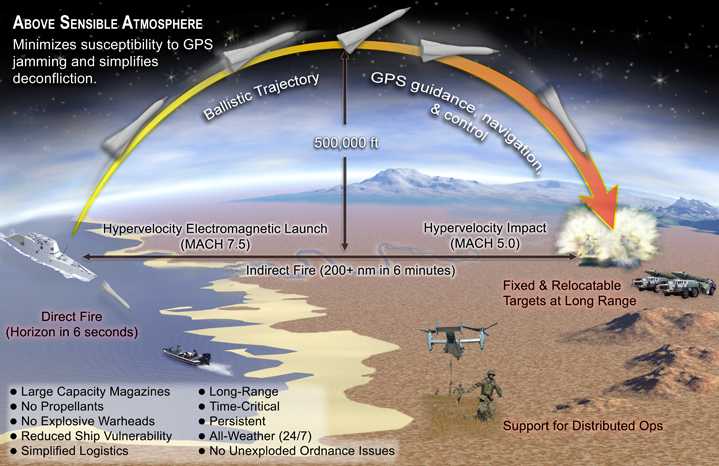
Electromagnetic Rail Gun ProposalRail guns have long been seen as a "Holy Grail" of naval weapons, as the technology promises hypersonic launch velocities without the use of conventional propellants. Instead of propellants, the output of the ship's power plant may be shunted into a large capacitive device, storing high levels of energy, which are released short bursts as the gun fires. Alternatively, a grouping of compensated pulsed alternators capable of delivering a momentary high spike of energy may be used. The latter approach appears to have the advantages of smaller footprints, inherent graceful degradation should one or more alternators fail, and lower total system weight.
A Rail Gun operates by making use of the Lorentz force created on a moving armature. The gun consists of two parallel rails electrically connected via an armature which holds the projectile. Current from the power source is sent down one rail, across the armature, and then down through the other rail back to the power source. This current flow creates a magnetic field around the armature, generating a propulsive force which slides it down the rails.
With large currents, railguns have the ability to produce great accelerations and thus high muzzle velocities, without the hazards of chemical explosive charges used in conventional guns. This reduces the vulnerability of the ship to damage, as there are no magazines, only shell rooms, and the shells themselves may not contain a burster. The hypersonic velocities generated give the projectiles large kinetic energies, long range, and short flight times.
BAE Systems won a contract to deliver a 32 megajoule lab launcher in June 2007 to the Office of Naval Research (ONR) Electromagnetic Launch Facility, located in Virginia at the Naval Surface Warfare Center's Dahlgren Division Laboratory. On 31 January 2008, test firing began with this launcher. The railgun was fired at 10.64MJ (megajoules) and the 7 lbs. (3.2 kg) test slug projectile attained a muzzle velocity of 8,268 fps (2,520 mps). A newer launcher is now under construction that will allow multiple shots and energies approaching 30MJ.
This weapon has fallen out of favor in the USN, with funding reduced for fiscal year 2021 budget request to $9.5 million, down from around $15 million requested in fiscal year 2020 and roughly $28 million in fiscal year 2019. This level of funding may move the railgun into the "promising, but not recommended for further development" category in the near future.
Like the Medieval search for the Holy Grail, the USN's search for a "Super Weapon" ultimately proved to be unsuccessful. In July 2021, the USN cancelled the Railgun development program, citing unresolved problems with barrel life and a low rate of fire. The Navy had spent about $500 million to develop the weapon. Future R&D funding will now go to other weapon systems such as anti-missile lasers.
The Hypervelocity Projectile (HVP) was originally developed as part of the railgun program but was later seen as being useful for conventional naval guns. See 5"/62 (12.7 cm) Mark 45 for details.
| Designation | N/A |
|---|---|
| Ship Class Used On | DDG-1000 (planned) |
| Date Of Design | N/A |
| Date In Service | 2020+ |
| Gun Weight | N/A |
| Gun Length oa | about 394 in (10.000 m) |
| Bore Length | N/A |
| Rifling Length | None |
| Grooves | Smooth-bore |
| Lands | Smooth-bore |
| Twist | Smooth-bore |
| Chamber Volume | None |
| Rate Of Fire | 6 to 12 rounds per minute 1 |
- ^The very nature of a Rail Gun means that it generates huge amounts of heat. Dissipating this heat will affect the rate of fire as well as the composition of the gun barrel. Some proposals see pumping liquid nitrogen through channels in the gun barrel and perhaps through the compensated pulse alternators as well. It should also be recognized that the friction generated by the armature as it travels at hypersonic velocities down the gun barrel will not be trivial and that the passing of large amounts of current through the armature will also be a significant contributor to heat build up.
| Type | Fixed |
|---|---|
| Weight of Complete Round | Saboted Kinetic Energy (KE) Round: 44 lbs. (20 kg)
Saboted Shrapnel Round: 44 lbs. (20 kg) Saboted HE Round: 44 lbs. (20 kg) |
| Projectile Types and Weights | KE 1a: 33 lbs. (15 kg)
Shrapnel 2a: N/A HE: N/A |
| Bursting Charge | KE and Shrapnel Rounds: None
HE: N/A |
| Projectile Length | about 30 in (76.2 cm) |
| Propellant Charge | None (Electromagnetic Propulsion) 3a |
| Muzzle Velocity | 8,200 fps (2,500 mps) |
| Working Pressure | N/A |
| Approximate Barrel Life | Prototype: 12 to 24 rounds |
| Ammunition stowage per gun | N/A 4a |
- ^As the KE projectile has very high impact velocities, the kinetic energy of a solid projectile is considered to be more than sufficient to destroy most targets, including hardened bunkers. For that reason, having a burster is not seen as necessary. This reduces the cost and complexity of the projectile, as it is effectively just a solid bullet needing only a GPS/Inertial guidance package that can withstand the high acceleration force generated as the round travels down the gun barrel, estimated to be about 40g. Testing by the US Army has demonstrated that the technology to build such a hardened guidance package already exists. As a result, the cost of each projectile is significantly lower than that of ERGM or LRLAP and was estimated in 2004 as being about $10,000 per round. However, this high-velocity may also mean that attacking reverse-slope targets with a Rail Gun projectile will be more difficult than with conventional weapons.
- ^Shrapnel round would contain up to 10,000 tungsten cubes. These would be dispersed moments before impact and could disable AFV as well as ground troops.
- ^One study estimated that generating enough energy to propel one round using compensated pulse alternators would take the equivalent of 3 gallons (11 liters) of fuel oil.
- ^As there are no propellant canisters and the volume needed for the compensated pulse alternators is relatively small, the volume normally used for storing propellant canisters can instead be used to store additional projectiles. As the projectiles themselves are significantly smaller than other long-range types such as ERGM or LRLAP, this again results in being able to store more Rail Gun projectiles in the same-size shell room. As a result of these factors, a Rail Gun ship should be able to carry perhaps two to three times as many projectiles as can a conventionally-armed warship.
- Breech energy would be about 150 megajoules with the muzzle energy of the saboted round being about 63 megajoules.
- Estimated Time of Flight for an MV of 8,200 fps (2,500 mps):
20 nm (36 km) = 6 seconds
200 nm (360 km) = 6 minutes
250 nm (450 km) = 7 minutes
| Elevation | Range |
|---|---|
| Maximum with 20 MJ Railgun | About 50 nm (93 km) |
| Maximum with 32 MJ Railgun | About 110 nm (204 km) |
As part of the rationale for canceling the Railgun program, the Navy cited that even a range of 110 nm (204 km) was insufficient to keep the firing ship out of the range of shore-based anti-ship missile systems. The rapid growth in range of such systems shows why the shorter-ranged ERGM, BTERM and LRLAP gun/missile projectiles could not meet the operational needs of the Navy.
| Designation | N/A |
|---|---|
| Weight | Using Pulsed Alternators: 74,120 lbs. (33,600 kg) |
| Elevation | About -5 / +70 degrees |
| Elevation Rate | N/A |
| Train | N/A |
| Train Rate | N/A |
| Gun recoil | N/A |
- All moving components are electrically driven.
- A Rail Gun firing at 12 rounds per minute is estimated to require 30 MW of power.
- Weights are based upon replacing an AGS mounting on a DD(X) destroyer with a 10 m Rail Gun installation.
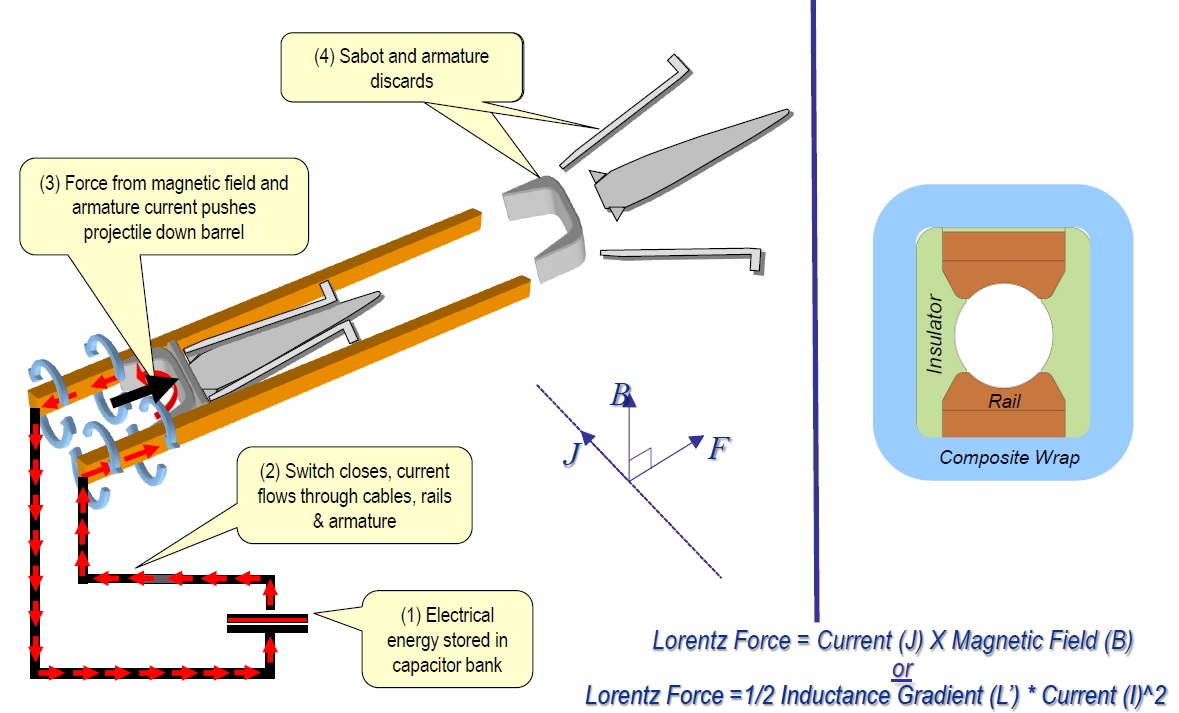
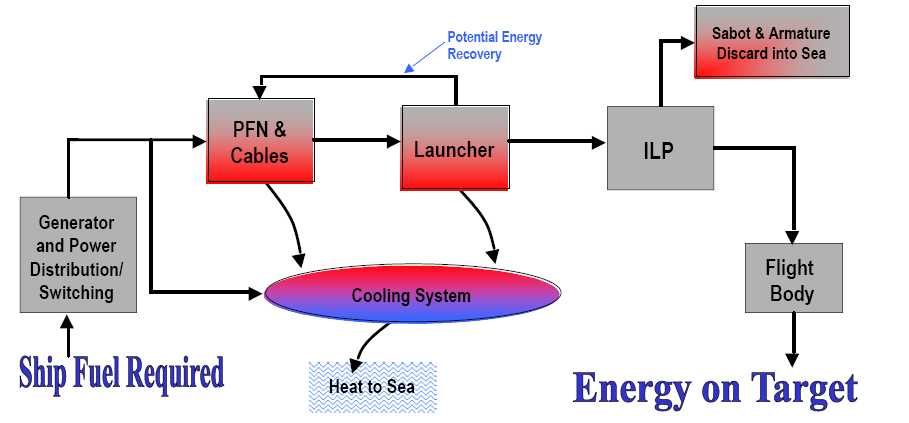
ILP = Integrated Launch Package
PFN = Pulse Forming Network
Image copyrighted by NAVSEA Dahlgren.
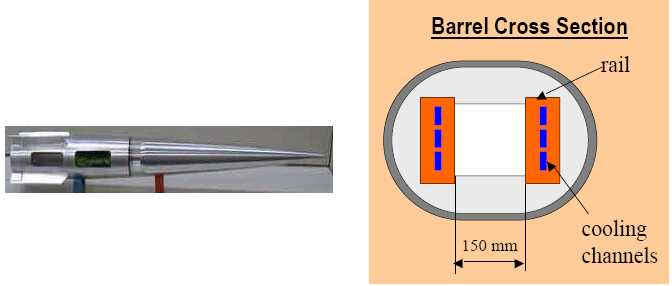
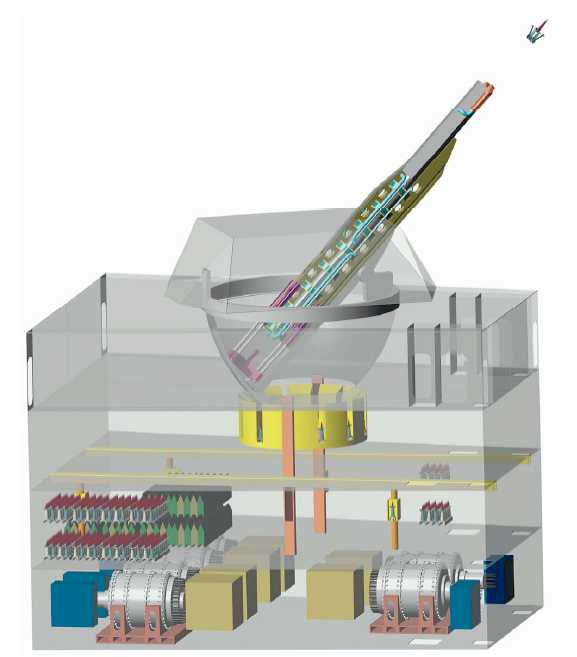
This view shows the Notional Rail Gun occupying the same volume as used by AGS. Note the Compensated Pulsed Alternators on the lowest deck, the small size of the projectile storage and the projectile emerging from the armature/sabot. Image copyrighted by NAVSEA Dahlgren.
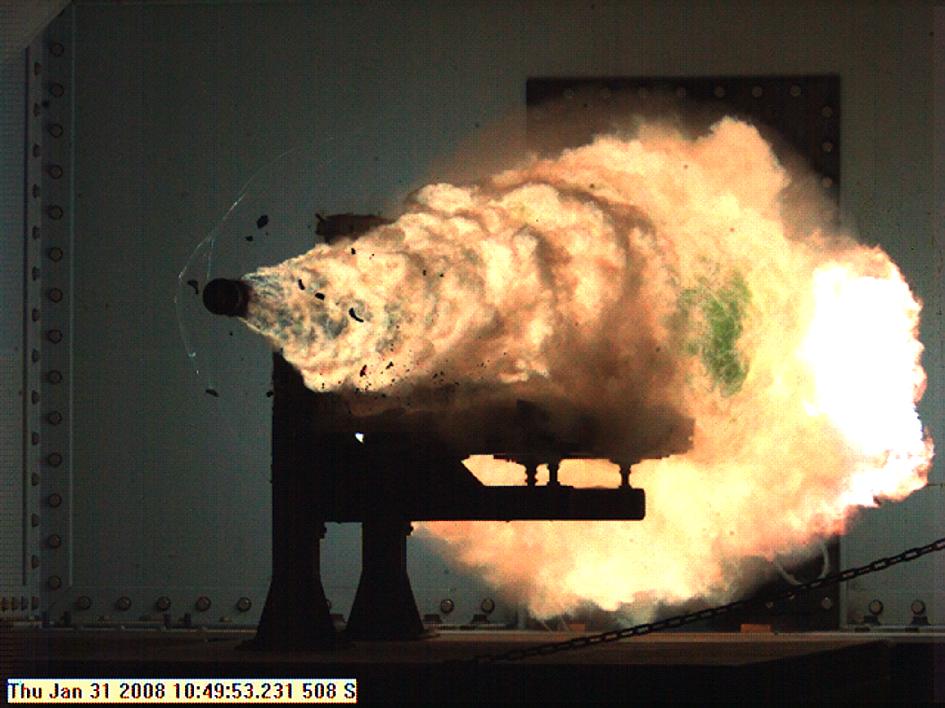
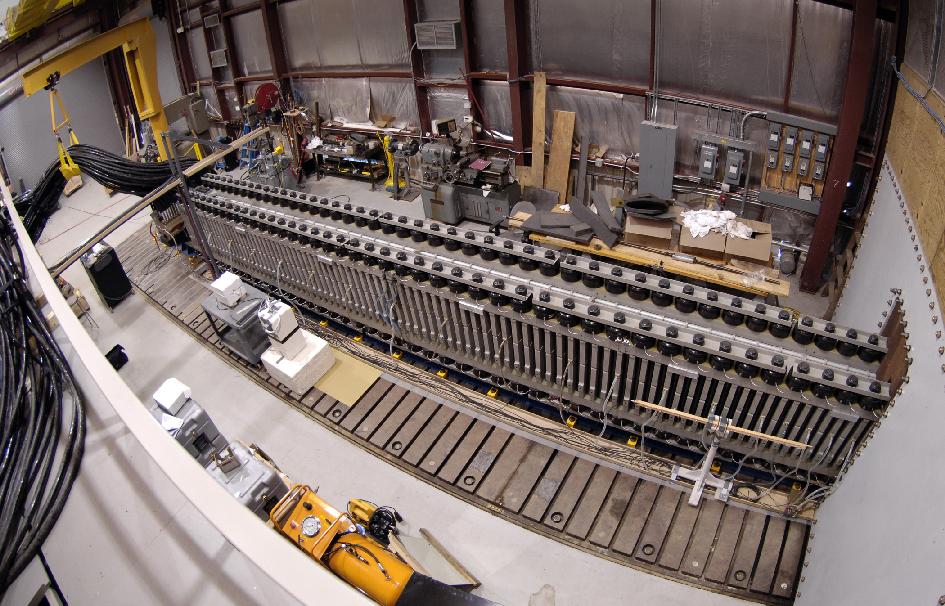
US Navy Photograph # 080128-N-7676W-027.
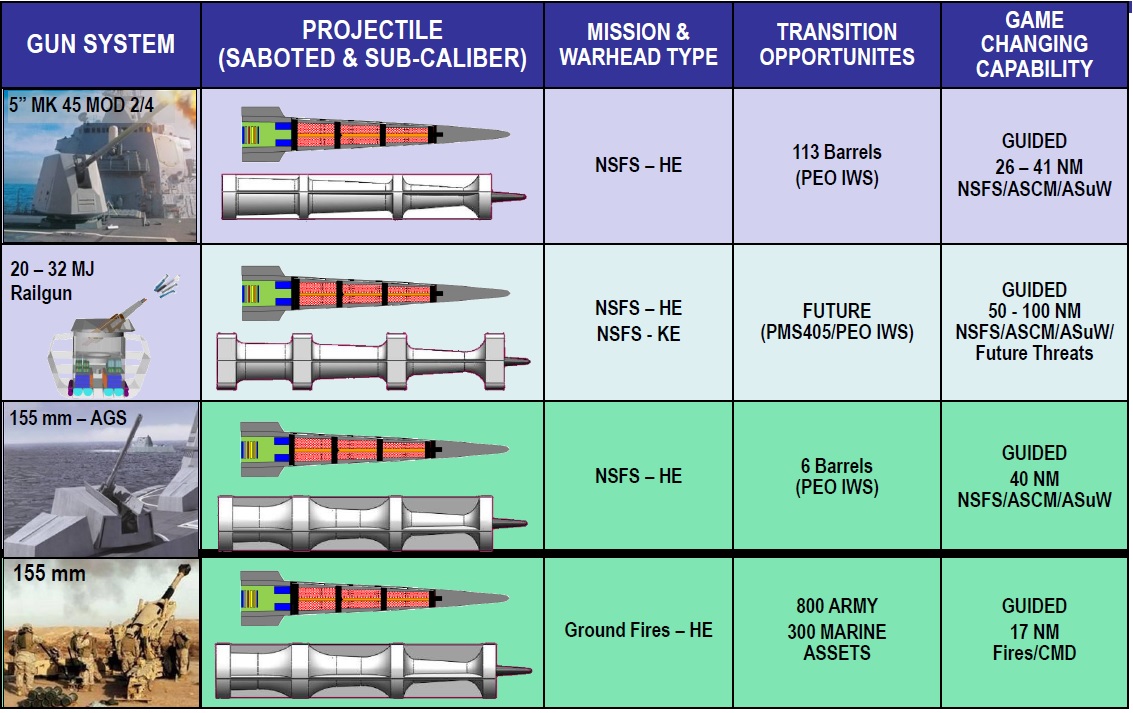
Video Clip of Railgun being Fired.
(requires Windows Media Player or Equivalent)
"Exploring the Possibilities of a Naval Electromagnetic Rail Gun" by Roger Ellis, NAVSEA Dahlgren, presented at the
NDIA 38th Annual Gun & Ammunition Symposium
"New S&T Futures for Navy-Marine Corps - Critical Capabilities for 2020" by Dr. Michael B. Deitchman, Head, Air
Warfare and Weapons Department, Office of Naval Research, presented at the NDIA Precision Strike, Winter Roundtable 2006
"Electromagnetic Railgun" by LCDR Jason
Fox, USN, Assistant PM, Railgun Ship Integration, presented at the NDIA
Joint Armaments Forum, 14 May 2014
---
"Naval Electromagnetic (EM) Gun Technology Assessment" by J. Bachkosky, D. Katz, R. Rumpf and W. Weldon of the Naval
Research Advisory Committee of Office of Naval Research
"Navy Planning To Construct New Test Facilities For Railguns, Lasers" by John M. Bennett, from Inside the Pentagon 07 October 2004
---
Office of Naval Research Press Releases
NAVSEA Dahlgren Press Releases
US Navy Press Releases
U.S. Navy Demonstrates World's Most Powerful EMRG at 10 Megajoules
---
"The Free Lance-Star" articles located at Fredricksburg.com:
Video of Railgun test shot at NAVSEA Dahlgren in October 2006 web-published on 20 January 2007
"A Missile Punch at Bullet Prices" web-published on 17 January 2008
"US Navy ditches futuristic railgun, eyes hypersonic missiles" by David Sharp, web-published at Defense News on 01 July 2021
---
Special help from Tom Kuvaputki
15 February 2008 - Benchmark
02 February 2014 - Corrected power requirements, redid "How a Rail Gun Works" and added Munition Commonality Sketch
14 June 2014 - Minor additions, added data source
28 March 2015 - Changed Video Clip link to point at Wayback Archives
01 August 2016 - Converted to HTML 5 format
08 September 2020 - Noted reduced funding in FY2021 and HVP interest
03 July 2021 - End of the EMRG programs, reorganized notes
30 March 2025 - Linked to HVP status on 127mm/62 datapage
